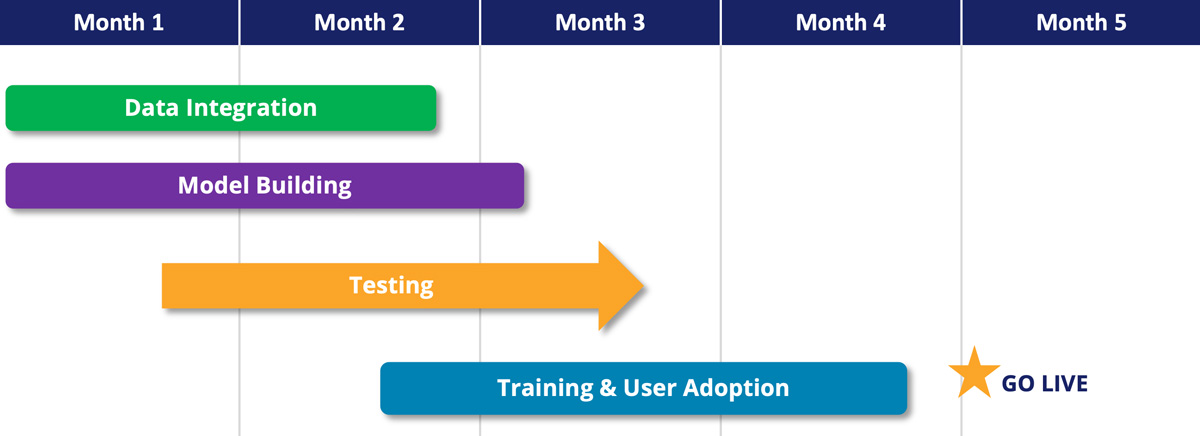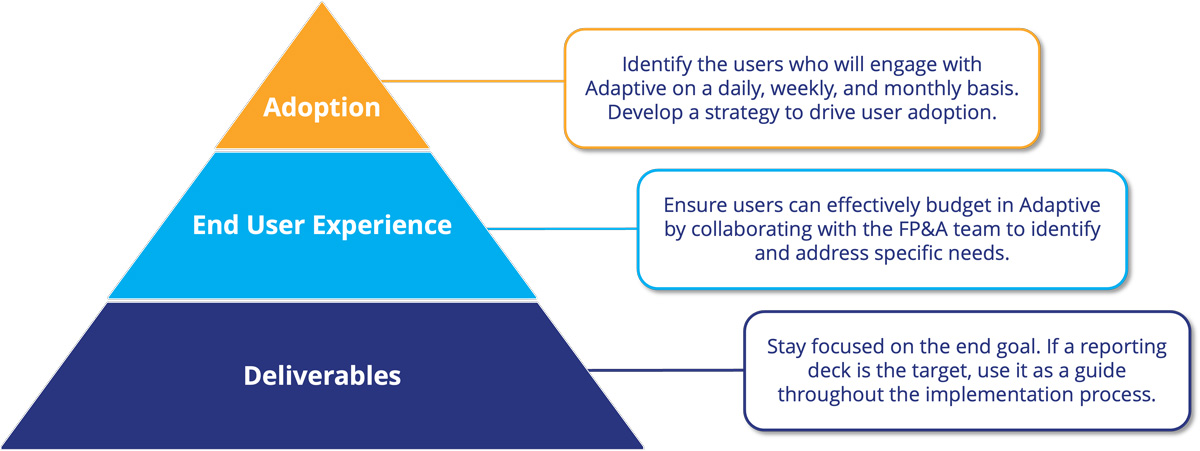You have selected Adaptive Planning as your new budgeting and forecasting software, and you want your implementation to be as seamless and positive as possible. That is why we have put together a few tips and considerations to think about before you begin.
Choose Your Timeframe
The number one thing you should do before implementing Adaptive is to think about your timeframe. You want to avoid starting the implementation during peak workloads and high-stress periods, such as year-end close or budget submissions.
Instead, align with key business cycles. Target a kick-off in Q1 or early Q2. This allows adequate time to build, test, and refine the system before the high-pressure budget season in late Q3 or early Q4. And consider aligning the go-live with a natural planning cycle, such as quarterly forecasts or the mid-year reforecast.
Your timing ensures key stakeholders have the bandwidth to contribute meaningfully to the deployment process and ensures the system is ready to support critical budgeting activities. And teams will need time to test new processes and gain confidence using Adaptive for real-world scenarios like budget approvals and forecasting.
It’s best to set a go-live target before budget season.
Sample Timeline:
- Allocate 2-3 months for model building, data integration, and testing
- Plan 1-2 months for training and user adoption to ensure the team is confident before full rollout
- Build in buffer time for unexpected delays, especially around data cleansing or stakeholder availability

Project Plan
Every project has its own unique requirements and considerations. While Commit is dedicated to partnering with every customer’s unique journey, here is our approach to Workday Adaptive Planning deployments at a high level.
Assemble Your Project Team
- Allocate 2-3 months for model building, data integration, and testing
- Plan 1-2 months for training and user adoption to ensure the team is confident before full rollout
- Build in buffer time for unexpected delays, especially around data cleansing or stakeholder availability
Conduct a Readiness Assessment
- Evaluate current processes, pain points, and goals.
- What manual processes in the budgeting cycle would you like to automate?
- Share your current budget workbook in excel with your consultant(s)
- Where are the roadblocks in your current process?
- Where is the FP&A team spending the most time?
- Create a process map of your current planning process
- What manual processes in the budgeting cycle would you like to automate?
- Conduct a systems audit
- Review your existing systems to determine what data and processes need to integrate with Adaptive Planning.
Plan the Rollout
- Define Implementation goals – clarify what success looks like (improved reporting efficiency, more accurate forecasting, or streamlined budgeting processes) and break goals into achievable milestones to track progress.
- Start with a phased approach (e.g., start with personnel planning followed by revenue planning). Resource availability can come into play here.
- Focus on high-impact areas first – What parts of the plan are important to YOUR company? (e.g., revenue forecasting, workforce planning).
- Define clear success metrics for implementation.
- Deliverables: Example: If we have a reporting workbook that we’re building towards, we can use that as the “Answer Key” to our implementation. We know we need to be able to produce these reports, so if we know them ahead of time, it makes the implementation a lot smoother
- End User Experience: Example: Ensure users can plan their operating expenses by Supplier while viewing prior year actuals
- Adoption: Roll out Adaptive to 25 department heads

- Data and Systems Integration
- Centralize data from key systems (e.g., ERP, CRM).
- Clean up and validate data to ensure accuracy in Adaptive Planning. Because Adaptive is a downstream system (it takes in data from other software such as Workday, Salesforce (CRM), or a data warehouse) you want to make sure the data is clean and how it will be used in the plan is defined ahead of implementation.
- Centralize data from key systems (e.g., ERP, CRM).
Build Your Scope
- Prioritize Features – align on the must-haves vs. the nice-to-haves.
- Understand Data Requirements – Map out required data inputs, including historical data, key drivers, and assumptions. Evaluate data sources and identify gaps.
- Create a realistic timeline for key activities: scoping, model building, data integration, testing, and training.
Level of Effort Considerations when Building Your Scope
Understanding the level of effort required is essential for setting realistic timelines, managing stakeholder expectations, and allocating resources effectively. Here’s how to evaluate and plan for the level of effort:
Business Process Name |
Description |
|---|---|
|
Scope Complexity |
The complexity of your scope directly impacts the level of effort. Single-Department vs. Multi-Department Implementation and Granularity of Models all impacts the complexity of your implementation. |
|
Data Requirements |
Data preparation and integration can be time-consuming. Historical data often needs to be cleaned and validated to ensure accuracy. This process can be lengthy if data sources are inconsistent or incomplete. |
|
Customization Needs |
Customization increases implementation effort. Standard templates and pre-built solutions for common use cases (e.g., workforce planning) require less effort. |
|
Team Expertise and Resources |
The skillset and availability of your team impact the level of effort. Internal Teams familiar with Adaptive Planning or financial modeling can accelerate the process. If training is required, additional time should be factored into the timeline. |
|
Rollout Approach – Phased vs. Big Bang |
The approach you choose affects effort allocation. Phased Rollout:
Big Bang Rollout:
|
|
Change Management and Training |
Ensuring users adopt the system adds to the overall effort. Change Resistance:
User Training:
|
|
Post-Implementation Maintenance |
Effort doesn’t stop after the initial rollout. Refinements and Adjustments:
Ongoing Updates:
|
Training and Change Management
We cannot emphasize end user adoption and training enough! By communicating the benefits of the new system to users and addressing potential points of resistance, you can ease the transition process.
Develop a training plan tailored to different user groups (e.g. executives, planners, and administrators). Offer comprehensive training to users at all levels and provide ongoing support and resources (e.g. help guides, internal champions).
We highly recommend that you build in time for teams to test new processes and gain confidence using Adaptive Planning for real-world scenarios before you go live.
Key Takeaways
We encourage you to assess your readiness and explore Adaptive Planning’s capabilities. Keep in mind the following key takeaways when you are ready to start the implementation process.
- Clearly define the scope and assess the level of effort upfront to set realistic expectations.
- Prioritize areas with the highest impact to streamline implementation.
- Consider leveraging external consultants or Adaptive-certified partners for complex projects or to reduce internal workload.
- Build in time for data preparation, user training, and post-launch adjustments to ensure a smooth transition and long-term adoption.
Integrations allow for importing Credit Card data from providers like AMEX, Mastercard, and VISA, enabling end users to include credit card information in their expense reports.
Commit is Here to Help
We want to ensure you have a successful implementation and a positive user experience. Let us help you avoid the common pitfalls and employ lessons we’ve learned in real-world deployments.
If you are ready to leverage the expertise of our Adaptive-certified consultants to help accelerate your implementation, contact us here!





